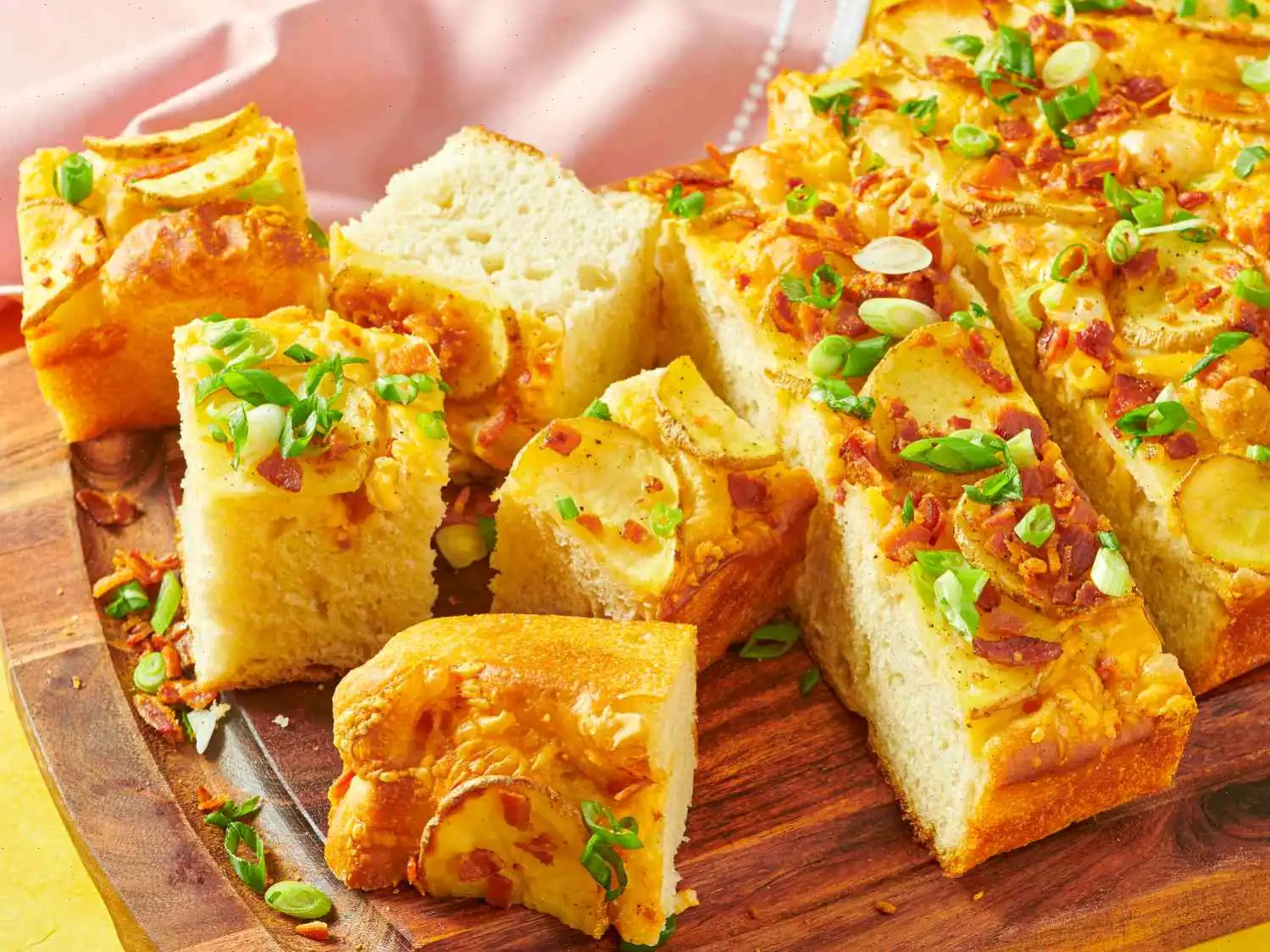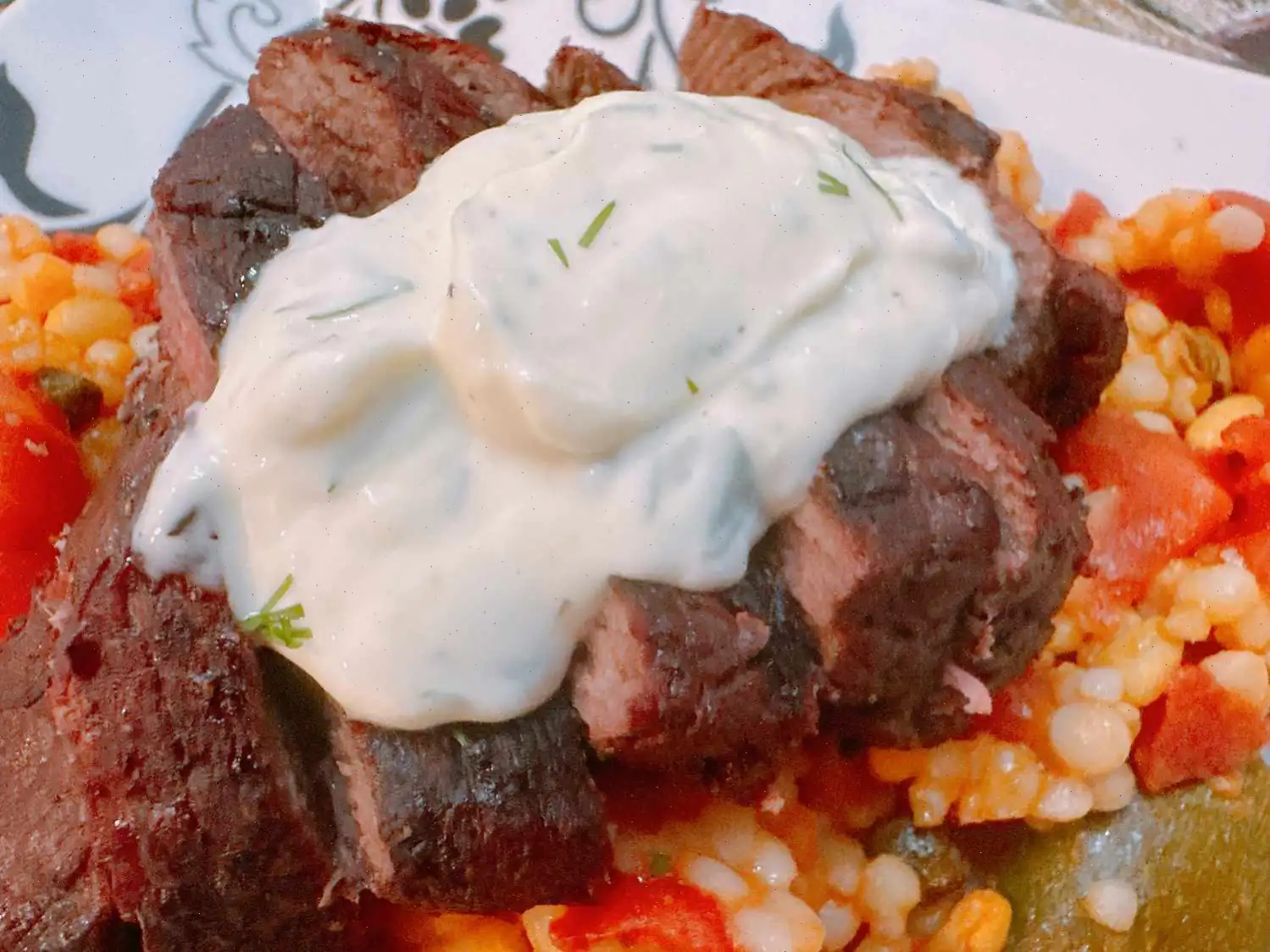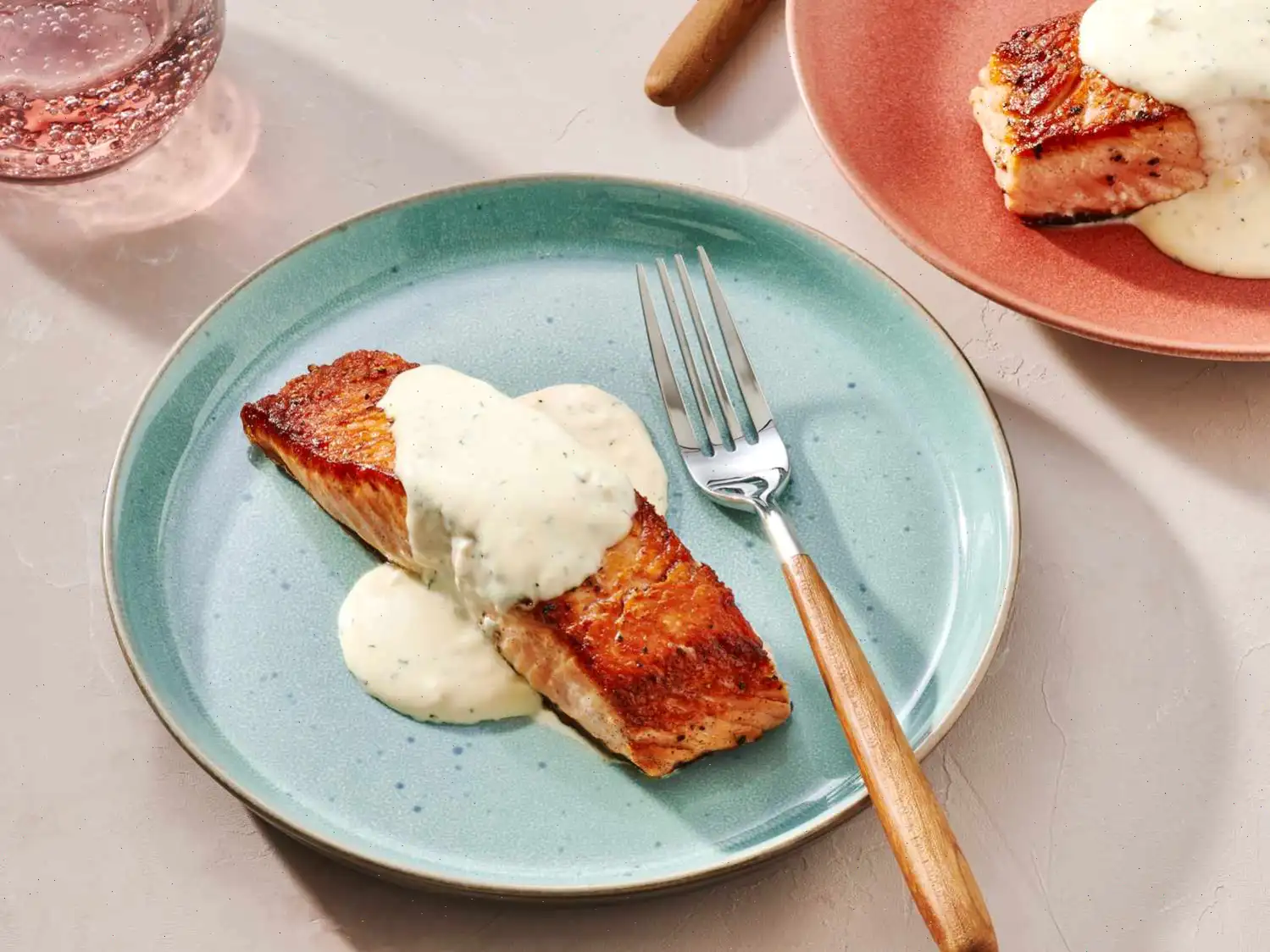
Loaded Potato Focaccia Recipe
Original recipe (1X) yields 8 to 10 servings
Ingredients
Focaccia Base
- 2 cups lukewarm water
- 1 (0.25 ounce) packet active-dry yeast, such as Red Star
- 1/2 teaspoon sugar
- 2 tablespoons olive oil
- 1 tablespoon kosher salt
- 3 cups all-purpose flour
- 2 cups bread flour
Loaded Potato Toppings
- Olive oil, as needed
- 1 Yukon gold potato, thinly sliced on a mandoline
- Kosher salt, to taste
- Freshly ground black pepper, to taste
- 1 cup shredded sharp Cheddar cheese
- 4 slices bacon, cooked and crumbled
- 2 scallions, thinly sliced
Directions
For the Focaccia Base
- Pour water into a large bowl and sprinkle yeast and sugar on top. Mix briefly with a dough whisk or wooden spoon, then let sit until the yeast blooms, about 10 minutes. The top should look foamy, like beer.
- Stir in olive oil and salt. Add both all-purpose and bread flour and mix until there are no dry streaks of flour. Use a dough whisk or wooden spoon.
- Cover the bowl and let the dough rise for 45 minutes.
- After 45 minutes, uncover the bowl. Wet your hands slightly and use your fingers to pull the top edge of the dough up and over the dough ball. Continue this process all around the dough, which is known as a stretch and fold. Cover the bowl again and let sit for another 30 minutes.
- Repeat the stretch and fold process two more times, 30 minutes apart. After the 4th set, cover the bowl and let the dough sit for an additional 30 minutes.
- By now, the dough should have doubled in volume and be smooth to the touch. You can use the dough immediately or chill it overnight for the next day.
For the Toppings
- Lightly oil a 9x13-inch metal cake pan. Gently stretch the focaccia dough into all four corners of the pan with your fingers.
- Cover the pan and allow the dough to rise for about 1 hour. During this time, preheat your oven to 450F (230C).
- Once the dough has risen, drizzle the surface with olive oil. Use your fingers to dimple the dough, then scatter the shredded Cheddar cheese in an even layer over the surface.
- Dimple the dough again, and layer the thin potato slices on top. Drizzle with more olive oil and season with salt and freshly ground black pepper. Sprinkle the crumbled bacon over the top.
- Bake in the preheated oven for 25 to 30 minutes, or until the focaccia and cheese are golden brown and bubbly.
- Once baked, remove the focaccia from the oven and let it sit in the pan for about 10 minutes. Carefully slide it onto a cutting board and let it cool for an additional 10 minutes.
- Before slicing and serving, sprinkle the sliced scallions over the top for added freshness and flavor.
Cook's Notes
If you prefer to weigh ingredients for the focaccia base, here are the ingredients by weight:
- 500 grams lukewarm water
- 1 (7 gram) packet active-dry yeast
- 1/2 teaspoon sugar
- 30 grams olive oil
- 15 grams kosher salt
- 400 grams all-purpose flour
- 250 grams bread flour
Nutrition Facts (per serving)
- Calories: 423
- Total Fat: 14g (18% Daily Value)
- Saturated Fat: 6g (28% Daily Value)
- Cholesterol: 27mg (9% Daily Value)
- Sodium: 640mg (28% Daily Value)
- Total Carbohydrate: 57g (21% Daily Value)
- Dietary Fiber: 3g (10% Daily Value)
- Total Sugars: 1g
- Protein: 15g (31% Daily Value)
- Vitamin C: 4mg (4% Daily Value)
- Calcium: 182mg (14% Daily Value)
- Iron: 3mg (14% Daily Value)
- Potassium: 311mg (7% Daily Value)
Note: Percent Daily Values are based on a 2,000-calorie diet. Your daily values may be higher or lower depending on your calorie needs.
The Story Behind Loaded Potato Focaccia
Loaded Potato Focaccia is a modern twist on the classic Italian focaccia, a flat oven-baked bread with a history dating back to Ancient Rome. Originally, focaccia was a simple bread seasoned with olive oil, herbs, and salt, often used as a staple alongside meals. Over centuries, regional bakers began experimenting with toppings, incorporating local ingredients to reflect seasonal availability and cultural preferences. The addition of potatoes, cheese, and bacon represents a fusion of Italian baking traditions with American comfort food, creating a hearty, flavorful bread that appeals to contemporary tastes.
Regional Characteristics
While traditional focaccia originates from Liguria, a coastal region in northwest Italy, this loaded version showcases an American influence. The use of Yukon gold potatoes and sharp Cheddar cheese highlights ingredients commonly found in American kitchens rather than the Italian staples like rosemary or sea salt alone. In northern Italy, focaccia often remains simple, occasionally topped with olives or onions, whereas in the United States, chefs embrace creative variations that combine savory toppings with a thick, airy focaccia base. This regional adaptation balances the chewy texture of Italian bread with the indulgent toppings associated with American casseroles and baked potato dishes.
Differences From Similar Dishes
Unlike a traditional baked potato, which is served individually with toppings on a soft interior, Loaded Potato Focaccia integrates the potato directly into the bread as a topping, offering a shared, communal dish. Compared to pizza, the bread is thicker, softer, and less tangy, lacking the fermented tomato sauce base but maintaining a similar dimpled surface. This recipe differentiates itself from other focaccia varieties by combining the sweetness and creaminess of thinly sliced potatoes with the savory crunch of bacon and the richness of melted Cheddar, making it a hybrid between bread, pizza, and casserole.
Where It's Typically Served
Loaded Potato Focaccia is versatile and can be served in multiple settings. It makes an excellent appetizer at dinner parties, a comforting side dish alongside soups and salads, or even a main dish for casual gatherings. Many American bakeries and bistros have started offering specialty focaccia varieties as part of brunch menus, highlighting their appeal as both an indulgent snack and a visually striking centerpiece. Its substantial toppings make it a crowd-pleasing choice for potlucks or holiday spreads, where sharing and presentation are key.
Interesting Facts
- The dimpled surface of focaccia is not just decorativeit helps the bread retain olive oil and toppings, enhancing flavor and texture.
- Using a stretch and fold method instead of traditional kneading allows the dough to develop gluten gradually, resulting in a softer, airier crumb.
- In Italy, focaccia is often eaten plain or with simple toppings, while in America, loaded versions like this one have become a culinary trend, blending classic techniques with inventive ingredients.
- The combination of potatoes and cheese on bread reflects a broader cultural trend of comfort food innovation, merging familiar flavors into a single, shareable dish.
- This recipe can be customized with seasonal vegetables or alternative cheeses, making it a flexible option for both home cooks and professional kitchens.
You can listen to this recipe in AI audio format. Simply click the play button below to listen to the content in a format that suits you best. It’s a great way to absorb information on the go!
FAQ about Loaded Potato Focaccia Recipe
Comments
Kenneth Williams
08/31/2024 02:31:32 PM
This product is incredible. I adore the potato topping. I prepared it myself. A five-star rating from me!








